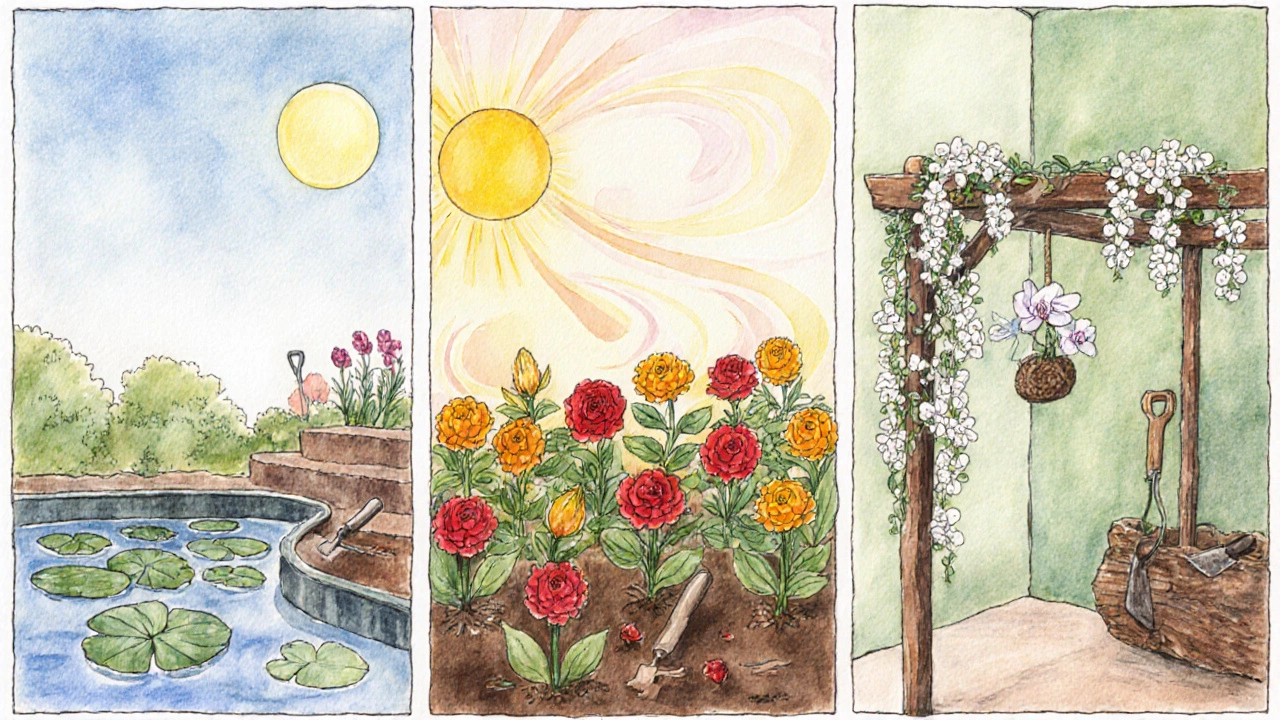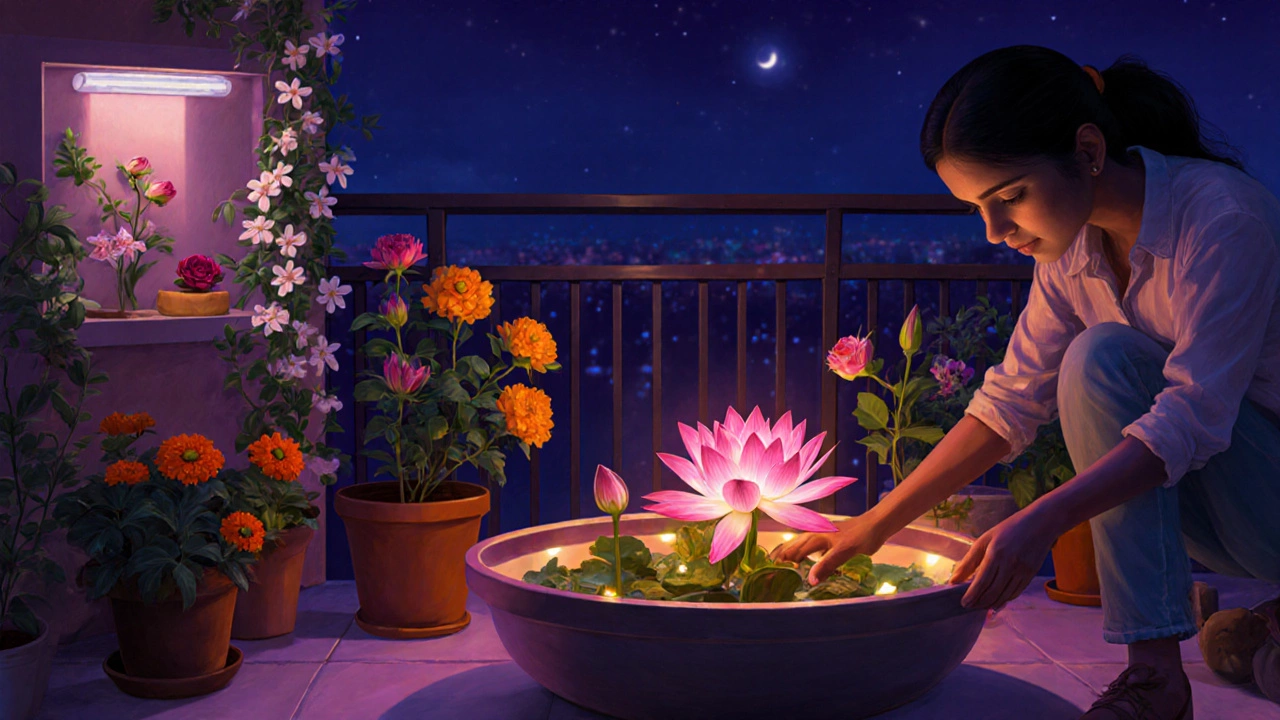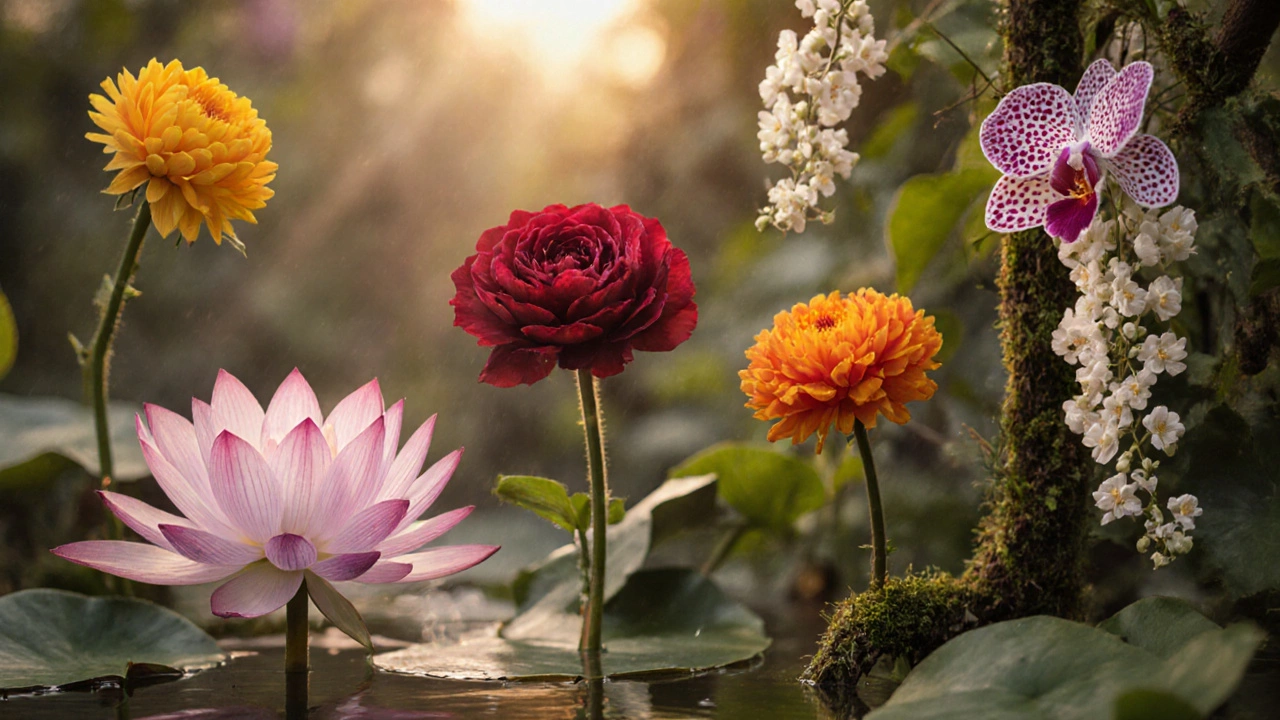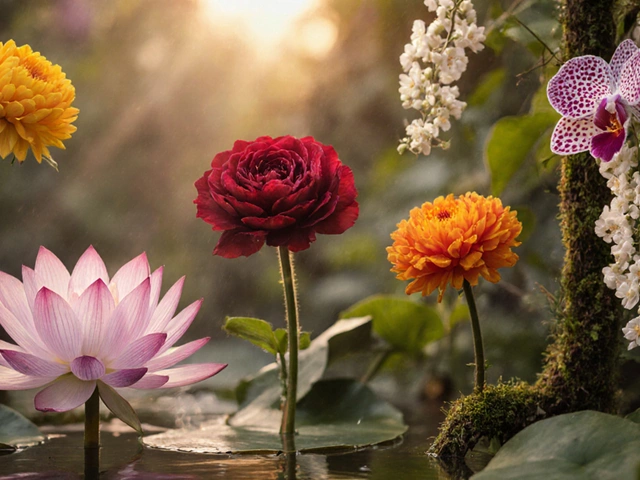India's Most Beautiful Flowers Quiz
Quiz Overview
Test your knowledge of India's most beautiful flowers. Learn about their symbolism, growing conditions, and cultural importance.
Quick Facts
- Lotus: National flower, symbolizes purity
- Rose: Represents love and passion
- Marigold: Festival favorite, auspicious
- Jasmine: Fragrant symbol of romance
- Orchid: Exotic beauty and luxury
Question 1 of 5
Results
Key Takeaways
- The lotus is India’s official national flower and a strong contender for the most beautiful.
- Roses, marigolds, jasmine, and orchids also rank high for beauty, cultural meaning, and garden appeal.
- Each flower thrives in specific Indian climates; matching the right species to your region boosts success.
- Understanding symbolism helps you pick a flower that fits celebrations or personal vibes.
- Simple care tips-soil, water, sunlight-can turn any of these beauties into a garden star.
India is a kaleidoscope of colors, and its flowers play a starring role. From street festivals to temple rituals, blossoms carry stories, prayers, and pure visual joy. If you’ve ever wondered which bloom takes the crown for sheer beauty, you’ve landed in the right spot. Below we’ll walk through the most celebrated candidates, break down what makes each special, and give you practical steps to grow them at home.
First up, the emblem of purity and elegance: Lotus (Nelumbo nucifera) is a large aquatic plant with broad, glossy leaves and striking pink‑white flowers that rise majestically from muddy water. It is India’s national flower, representing spiritual enlightenment in Hindu and Buddhist traditions.
But beauty is a matter of taste, and India’s floral palette offers several rivals. Let’s meet the others that consistently win hearts across the subcontinent.
Cultural Roots: Why Flowers Matter in India
From the fragrant garlands offered at temples to the vivid rangoli designs during festivals, flowers are woven into daily life. Each blossom carries a symbolic weight: white jasmine stands for purity, red roses echo love, while marigolds shout celebration. Knowing these meanings helps you pick a bloom that resonates with the occasion you have in mind.
Top Contenders for the Beauty Crown
Rose (Rosa spp.) has ruled romance worldwide, and India is no exception. With over 30 varieties grown locally- from the deep crimson ‘Maharani’ to the sunny yellow ‘Rajkumari’- roses showcase a spectrum of colors and a classic layered petal shape that screams elegance.
Marigold (Tagetes erecta) is the festival favorite. Its bright orange‑yellow heads line every street during Diwali, creating an instant visual punch. The flower’s dense, globe‑like form and hardy nature make it an easy‑care beauty.
Jasmine (Jasminum officinale) exudes a sweet, heady fragrance that fills entire courtyards. White, star‑shaped blossoms appear in clusters, often dangling from trellises, turning a simple garden into a scented sanctuary.
Orchid (Orchidaceae family) may sound exotic, and it is. Indian species like the Phalaenopsis and the native Hooded Orchid (Cymbidium aloifolium) bring startling colors and intricate shapes that feel almost otherworldly.
Hibiscus (Hibiscus rosa‑sinensis) bursts with large, trumpet‑shaped blooms in reds, pinks, yellows, and whites. Its bold presence on temple walls and in home gardens makes it a visual anchor.
Two more lesser‑known gems deserve a shout‑out. Indian Tulip (Tulipa baurii) blooms high in the Himalayas, offering delicate pink‑lavender cups that survive harsh mountain climates. Then there’s the Himalayan Blue Poppy (Meconopsis betonicifolia), a sky‑blue marvel that paints alpine meadows with a rare hue.

Quick Comparison of the Top Five
| Flower | Scientific Name | Primary Symbolism | Typical Bloom Season | Best Growing Zones in India |
|---|---|---|---|---|
| Lotus | Nelumbo nucifera | Purity, Spiritual Enlightenment | June‑September | Pond/low‑land wetlands, North & East India |
| Rose | Rosa spp. | Love, Passion | January‑December (varies by variety) | Temperate plains, hill stations |
| Marigold | Tagetes erecta | Celebration, Auspiciousness | October‑February | All regions, especially dry zones |
| Jasmine | Jasminum officinale | Purity, Romance | February‑May | Warm coastal & inland areas |
| Orchid | Orchidaceae family | Exotic Beauty, Luxury | Varies; many are year‑round indoors | Shaded, humid zones; also as houseplant |
How to Grow These Beauties in Indian Conditions
Lotus loves standing water. Start with a wide, shallow container, fill it with at least 12‑15cm of water, and plant tubers in a rich, loamy mix. Keep the water level steady and place the pot in full sun. Fertilize monthly with a low‑nitrogen aquatic fertilizer.
Roses need well‑drained, slightly acidic soil (pH6‑6.5). Add compost and organic manure before planting. Prune early spring to encourage air flow, and water at the base to avoid fungal spots. A balanced N‑P‑K (10‑10‑10) every 6weeks keeps blooms vibrant.
Marigolds are tough. Scatter seeds directly into the garden after the monsoon recedes. They thrive in full sun and well‑drained sand‑loam. Water sparingly; over‑watering leads to root rot. Pinch back the flower heads to prolong the display.
Jasmine prefers loamy, slightly alkaline soil and partial shade. Plant in early spring, then mulch to retain moisture. Once established, it needs only light watering. A monthly feed of liquid seaweed boosts fragrance.
Orchids grown as houseplants demand indirect light, high humidity, and a bark‑based medium that drains quickly. Water once a week, but let the medium dry out between waterings. Feed with a diluted orchid fertilizer (20‑20‑20) every two weeks during active growth.
For Hibiscus, sow seeds or cuttings in warm, sunny spots. Use a soil blend of garden loam, sand, and compost (2‑1‑1). Regular pruning stimulates bushier growth and larger blooms. Watch for aphids during the monsoon.
Indian Tulip and Himalayan Blue Poppy both need cool, moist conditions. Plant in raised beds with rich organic matter and a shade net if temperatures rise above 20°C. These alpine species appreciate well‑drained gravelly soil and minimal fertilizer.
Choosing the Right Flower for Your Garden or Home
- If you love water features and spiritual vibes, go for the lotus. It’s an eye‑catcher in ponds and small water basins.
- For classic romance and a variety of colors, roses are the safe bet, especially in temperate climates.
- Need a low‑maintenance, festival‑ready splash? Marigolds need almost no fuss.
- Craving an all‑season perfume? Jasmine will perfume your evenings with minimal care.
- Want exotic flair and can manage indoor humidity? Orchids fit the bill.
- Looking for a bold, tropical statement plant? Hibiscus delivers massive, bright blooms.
- Living in the hills and love delicate shades? Indian Tulip or Himalayan Blue Poppy add rare charm.

Common Pitfalls and How to Fix Them
Yellowing leaves on lotus usually signal nutrient deficiency or too much shade. Add a slow‑release aquatic fertilizer and shift the pot to a sunnier spot.
Black spot on roses is a fungal issue. Remove affected petals, spray a copper‑based fungicide, and improve air circulation.
Marigold stems collapsing often means waterlogged soil. Ensure drainage and switch to a lighter soil mix.
Jasmine losing fragrance can be due to over‑pruning. Leave some older woody stems; they store the aromatic oils.
Orchid roots turning mushy indicate rot from excess water. Repot in fresh bark medium and cut away any brown roots.
Next Steps: Bringing the Beauty Home
Pick one flower that speaks to you and start small-maybe a pot of lotus or a few rose cuttings. Track the soil, water, and sunlight conditions for the first month; adjustments early on save a lot of trouble later. Join local gardening groups or online forums; Indian gardeners love swapping seed packets and success stories.
Frequently Asked Questions
Which flower is officially the most beautiful in India?
Officially, the Lotus is India’s national flower and is widely regarded as the most beautiful due to its cultural symbolism and striking appearance.
Can I grow lotus in a small balcony garden?
Yes. Use a wide, shallow container at least 12cm deep, fill with water, and place the lotus tuber in a heavy, loamy mix. Keep it in full sun and change the water weekly.
What’s the easiest flower for a beginner gardener in India?
Marigold. It tolerates a wide range of soils, needs minimal water, and thrives in full sun, making it perfect for novices.
Do orchids need special lighting indoors?
Orchids prefer bright, indirect light-think an east‑facing window with a sheer curtain. Direct midday sun can burn the leaves.
How can I make my garden look more colorful year‑round?
Combine fast‑growing annuals like marigold for the hot months with perennials such as hibiscus and rose, and add a few container orchids for indoor color during the cooler season.


